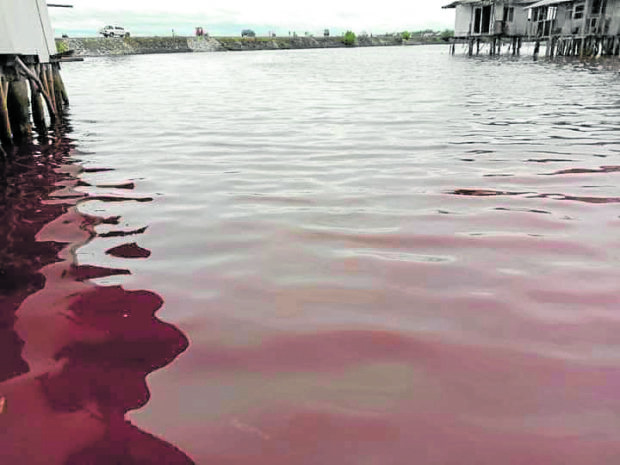Red tide alert up in Misamis Occidental, Camiguin waters

BLOOD RED Water underneath houses in four villages in Ozamiz City turns red, causing alarm among residents. The Bureau of Fisheries and Aquatic Resources says tests on water samples confirmed the presence of red tide toxin in the area. —THATA ROXAS/CONTRIBUTOR
ILIGAN CITY—Water along the coastal area of Ozamiz City in Misamis Occidental province has turned blood red, which the Bureau of Fisheries and Aquatic Resources (BFAR) said was due to the presence of red tide toxins.
The BFAR said the red tide alert covers the Murcielagos Bay of Misamis Occidental stretching across the sea to the town of Mahinog on the island-province of Camiguin.
Residents of the seaside village of San Roque in Ozamiz were alarmed to see the seawater underneath their houses turn blood red since last week, prompting them to alert the BFAR and the police.
Later, BFAR aquaculturists took water samples from the area and later confirmed that the sea was contaminated with red tide toxins. Aside from San Roque, the villages of Santa Cruz, Carmen Annex, Triumfo and Malaubang in the city were also affected.
BFAR officials warned the public against eating shellfish from these waters as laboratory tests confirmed these were positive for paralytic shellfish poison, based on samples taken from Murcielagos Bay, particularly in Sapang Dalaga and Baliangao towns, the coastal waters of Ozamiz City, and Taguines Lagoon in the village of Benoni in Mahinog.
“All types of shellfish and Acetes species, locally known as ‘alamang’ or ‘hipon,’ gathered from the areas are not safe for human consumption,” said the BFAR advisory posted on Friday.
Algal blooms
“Fish, squid, crab and shrimp are safe to eat provided that all entrails are removed and washed thoroughly with running water before cooking,” the advisory added.
Red tide is a common name for algal blooms, which are large concentrations of aquatic microorganisms such as protozoans and unicellular algae, Virginia Balde, senior aquaculturist of BFAR Misamis Occidental, explained.
She said the upwelling of nutrients from the seafloor, often following massive storms, usually provided the conducive environment for algae to thrive, triggering algae bloom events.
She said that Misamis Occidental already had a history of nontoxin red coloration, which triggered a fish kill in 2004 and in 2014, because of the oxygen depletion in the water. “The algae also clogged the gills of fish (resulting in the fish kill) but there was no poisoning at that time,” Balde said.
“Ozamiz City did not have a history of red tide until now, but Murcielagos Bay, Baliangao and Sapang Dalaga already had a history of PSP (paralytic shellfish poisoning) in 2009 to 2013,” she added.